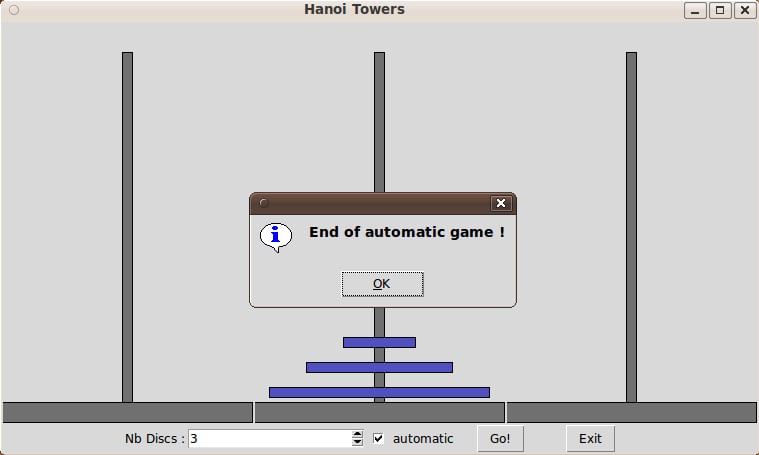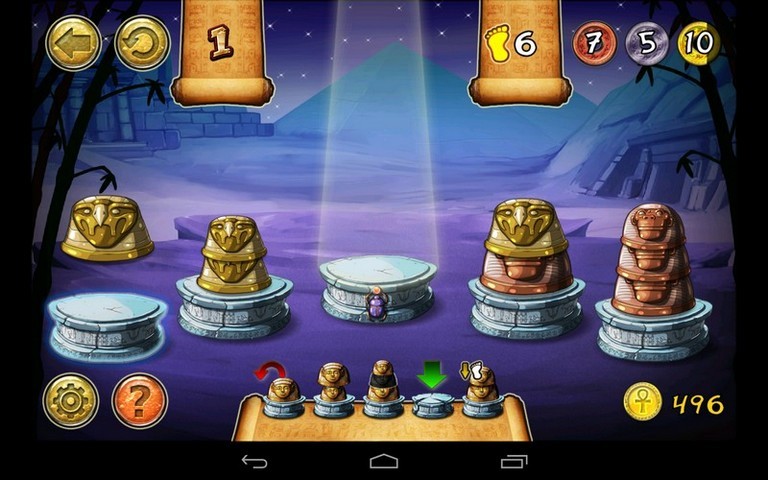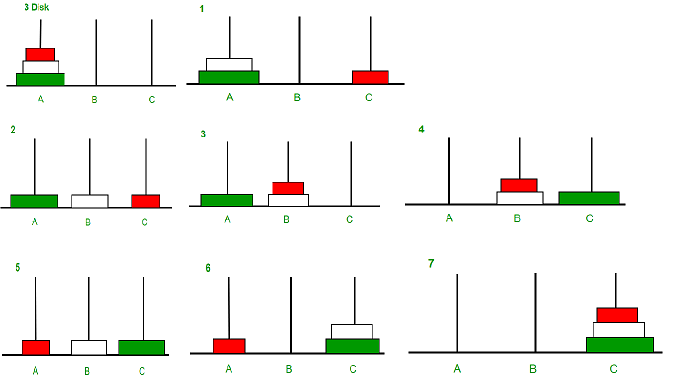
The presence of the largest disk does not impede any move of the h-1 smaller disks and can temporarily be ignored. Subsequently move the largest disk and finally move the h-1 smaller disks from peg r to peg t. Hence, first all h-1 smaller disks must go from f to r. The only situation that allows this move is when all smaller h-1 disks are on peg r. If h>1, then somewhere along the sequence of moves, the largest disk must be moved from peg f to another peg, preferably to peg t. If h=1, then simply move the disk from peg f to peg t. If there is only one disk (or even none at all), the problem is trivial. If a solution is known moving from peg f to peg t, then, by renaming the pegs, the same solution can be used for every other choice of starting and destination peg. First, observe that the problem is symmetric for permutations of the names of the pegs ( symmetric group S 3).
#HANOI TOWERS CODEWARS HOW TO#
When the turn is to move the non-smallest piece, there is only one legal move.Īs in many mathematical puzzles, finding a solution is made easier by solving a slightly more general problem: how to move a tower of h (h=height) disks from a starting peg f (f=from) onto a destination peg t (t=to), r being the remaining third peg and assuming t ≠ f. If there is no tower in the chosen direction, move it to the opposite end. When moving the smallest piece, always move it in the same direction (either to the left or to the right, but be consistent). The following solution is a simple solution for the toy puzzle.Īlternate moves between the smallest piece and a non-smallest piece. The game seems impossible to many novices, yet is solvable with a simple algorithm:

Most toy versions of the puzzle have 8 disks. The Flag Tower of Hanoi may have served as the inspiration for the name.

In some versions, other elements are introduced, such as the fact that the tower was created at the beginning of the world, or that the priests or monks may make only one move per day. The temple or monastery may be said to be in different parts of the world - including Hanoi, Vietnam, and may be associated with any religion. For instance, in some tellings, the temple is a monastery and the priests are monks. There are many variations on this legend. (In context, the universe is currently about 13.7 billion years old.) If the legend were true, and if the priests were able to move disks at a rate of one per second, using the smallest number of moves, it would take them 2 64−1 seconds or roughly 600 billion years (operation taking place is ). The Tower of Hanoi is a problem often used to teach beginning programming, in particular, as an example of a simple recursive algorithm. It is not clear whether Lucas invented this legend or was inspired by it. The puzzle is therefore also known as the Tower of Brahma puzzle. According to the legend, when the last move of the puzzle is completed, the world will end. The priests of Brahma, acting out the command of an ancient prophecy, have been moving these disks, in accordance with the rules of the puzzle. There is a legend about an Indian temple which contains a large room with three time-worn posts in it surrounded by 64 golden disks. The puzzle was invented by the French mathematician Édouard Lucas in 1883. 6.1 Description of the presumed-optimal solution.2.2.3 Solution from an arbitrary initial configuration.No disk may be placed on top of a smaller disk.Each move consists of taking the upper disk from one of the pegs and sliding it onto another peg, on top of the other disks that may already be present on that peg.The objective of the puzzle is to move the entire stack to another peg, obeying the following rules: The puzzle starts with the disks neatly stacked in order of size on one peg, the smallest at the top, thus making a conical shape. It consists of three pegs, and a number of disks of different sizes which can slide onto any peg. The Tower of Hanoi or Towers of Hanoi is a mathematical game or puzzle. Let is also used to declare variables(new way)Ĭonst is used to declare const values.A model set of the Towers of Hanoi (with 8 disks) File:Tower of Hanoi 4.gifĪn animated solution of the Tower of Hanoi puzzle for T(4,3). Var is used to declare variables(old way of declaring variables)

Executable in both browser and server which has Javascript engines like V8(chrome), SpiderMonkey(Firefox) etc.Embedded along with HTML and makes web pages alive.Javascript is required to design the behaviour of the web pages.

Javascript(JS) is a object-oriented programming language which adhere to ECMA Script Standards.
#HANOI TOWERS CODEWARS CODE#
The editor shows sample boilerplate code when you choose language as Javascript and start coding. Getting started with the OneCompiler's Javascript editor is easy and fast. It's one of the robust, feature-rich online compilers for Javascript language. Write, Run & Share Javascript code online using OneCompiler's JS online compiler for free.


 0 kommentar(er)
0 kommentar(er)
